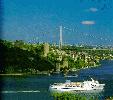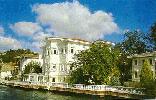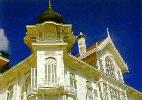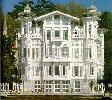| The Bosphorus... |
|
The Bosphorus, which connects Marmara Sea and Black Sea, is one of the most exquisite places in the world, with a width
of maximum 3,200 m and minimum 550 m, maximum depth of 118 m and its length is 31,5 km. It was naturally formed at the
beginning of the IVth Geological Era as the sea water occupied the deep valley. During the ages of Byzantine
and Ottoman Empire small settlements Cropped up at both shores of Bosphorus and it was very much esteemed by the sultans
and pashas where they built their kiosks and “yali”s (water-side residences) as of the 18th century.
Wearing effect of time caused the wooden buildings demolish and they were replaced with new ones. In place of the wooden
Besiktas Palaces there appeared the Dolmabahçe Palace and also Beylerbeyi Palace was rebuilt while stone buildings like
Göksu were built and gave the Bosphorus its final outlook. With its architecture matching its natural delights the
Bosphorus reached and incomparable beauty. The buildings embroidering the shores of free-flowing waters, being embraced
by a green background as a whole offer a view of unceasing delight. Such a wonderful cruise will provide unforgettable
memories. For this to attend a trip with a tourist ferry taking off from the Eminönü Jetty will suffice. If you have the
opportunity to take part in one of the private boat cruises or yachts, the trip will be even more delightful. Our tourist
ferry will start leaving Topkapi Palace, St. Sophia and Süleymaniye Mosque behind. The Karaköy Jetty will be crossed
arriving in front of Tophane. Here we see the Nusretiye Mosque, built by Sultan Mahmut II in Empiric style in 1825. The
lead-covered mosque behind this mosque is a work of Mimar Sinan, who dedicated it to Kilic Ali Pasha. Passing Findikli and
the very lively Kabatas Jetty, the Dolmabahçe Palace appears with its mosque and Clock Tower. The mosque was dedicated to
Sultan Abdülmecit’s mother, Bezm-ialem Valide Sultan and was built by Mimar Karabet Balyan in 1853. The Clock Tower
between the mosque and the palace is 27 m high, and was built by Mimar Serkis Balyan in 1890 during Sultan Abdülhamit's
reign. The palace built by Karabet Balyan by the order of Sultan Abdülmecit between the years 1843-1856 is 284 m long, and
it is an ornament to the Bosphorus. The palace has three stories consisting of the men’s part, entertainment hall and
the harem. The separate premises next to the palace used to be the crown prince’s residence and today serves as the
Paintings and Statues museum.
|
|

|










